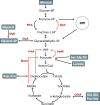Defining the Metabolic Pathways and Host-Derived Carbon Substrates Required for Francisella tularensis Intracellular Growth
- PMID: 30459188
- PMCID: PMC6247087
- DOI: 10.1128/mBio.01471-18
Defining the Metabolic Pathways and Host-Derived Carbon Substrates Required for Francisella tularensis Intracellular Growth
Abstract
Francisella tularensis is a Gram-negative, facultative, intracellular bacterial pathogen and one of the most virulent organisms known. A hallmark of F. tularensis pathogenesis is the bacterium's ability to replicate to high densities within the cytoplasm of infected cells in over 250 known host species, including humans. This demonstrates that F. tularensis is adept at modulating its metabolism to fluctuating concentrations of host-derived nutrients. The precise metabolic pathways and nutrients utilized by F. tularensis during intracellular growth, however, are poorly understood. Here, we use systematic mutational analysis to identify the carbon catabolic pathways and host-derived nutrients required for F. tularensis intracellular replication. We demonstrate that the glycolytic enzyme phosphofructokinase (PfkA), and thus glycolysis, is dispensable for F. tularensis SchuS4 virulence, and we highlight the importance of the gluconeogenic enzyme fructose 1,6-bisphosphatase (GlpX). We found that the specific gluconeogenic enzymes that function upstream of GlpX varied based on infection model, indicating that F. tularensis alters its metabolic flux according to the nutrients available within its replicative niche. Despite this flexibility, we found that glutamate dehydrogenase (GdhA) and glycerol 3-phosphate (G3P) dehydrogenase (GlpA) are essential for F. tularensis intracellular replication in all infection models tested. Finally, we demonstrate that host cell lipolysis is required for F. tularensis intracellular proliferation, suggesting that host triglyceride stores represent a primary source of glycerol during intracellular replication. Altogether, the data presented here reveal common nutritional requirements for a bacterium that exhibits characteristic metabolic flexibility during infection.IMPORTANCE The widespread onset of antibiotic resistance prioritizes the need for novel antimicrobial strategies to prevent the spread of disease. With its low infectious dose, broad host range, and high rate of mortality, F. tularensis poses a severe risk to public health and is considered a potential agent for bioterrorism. F. tularensis reaches extreme densities within the host cell cytosol, often replicating 1,000-fold in a single cell within 24 hours. This remarkable rate of growth demonstrates that F. tularensis is adept at harvesting and utilizing host cell nutrients. However, like most intracellular pathogens, the types of nutrients utilized by F. tularensis and how they are acquired is not fully understood. Identifying the essential pathways for F. tularensis replication may reveal new therapeutic strategies for targeting this highly infectious pathogen and may provide insight for improved targeting of intracellular pathogens in general.
Keywords: Francisella tularensis; GdhA; GlpA; carbon metabolism; intracellular pathogen.
Copyright © 2018 Radlinski et al.
Figures






Similar articles
-
Differential Substrate Usage and Metabolic Fluxes in Francisella tularensis Subspecies holarctica and Francisella novicida.Front Cell Infect Microbiol. 2017 Jun 21;7:275. doi: 10.3389/fcimb.2017.00275. eCollection 2017. Front Cell Infect Microbiol. 2017. PMID: 28680859 Free PMC article.
-
Francisella tularensis disrupts TLR2-MYD88-p38 signaling early during infection to delay apoptosis of macrophages and promote virulence in the host.mBio. 2023 Aug 31;14(4):e0113623. doi: 10.1128/mbio.01136-23. Epub 2023 Jul 5. mBio. 2023. PMID: 37404047 Free PMC article.
-
A method for functional trans-complementation of intracellular Francisella tularensis.PLoS One. 2014 Feb 4;9(2):e88194. doi: 10.1371/journal.pone.0088194. eCollection 2014. PLoS One. 2014. PMID: 24505427 Free PMC article.
-
Proteins involved in Francisella tularensis survival and replication inside macrophages.Future Microbiol. 2012 Nov;7(11):1255-68. doi: 10.2217/fmb.12.103. Future Microbiol. 2012. PMID: 23075445 Review.
-
Importance of Metabolic Adaptations in Francisella Pathogenesis.Front Cell Infect Microbiol. 2017 Mar 28;7:96. doi: 10.3389/fcimb.2017.00096. eCollection 2017. Front Cell Infect Microbiol. 2017. PMID: 28401066 Free PMC article. Review.
Cited by
-
Pathogenicity and virulence of Francisella tularensis.Virulence. 2023 Dec;14(1):2274638. doi: 10.1080/21505594.2023.2274638. Epub 2023 Nov 8. Virulence. 2023. PMID: 37941380 Free PMC article. Review.
-
Interferon Gamma Reprograms Host Mitochondrial Metabolism through Inhibition of Complex II To Control Intracellular Bacterial Replication.Infect Immun. 2020 Jan 22;88(2):e00744-19. doi: 10.1128/IAI.00744-19. Print 2020 Jan 22. Infect Immun. 2020. PMID: 31740527 Free PMC article.
-
Functional characterization of Francisella tularensis subspecies holarctica genotypes during tick cell and macrophage infections using a proteogenomic approach.Front Cell Infect Microbiol. 2024 Mar 4;14:1355113. doi: 10.3389/fcimb.2024.1355113. eCollection 2024. Front Cell Infect Microbiol. 2024. PMID: 38500499 Free PMC article.
-
Origins of Metabolic Pathology in Francisella-Infected Drosophila.Front Immunol. 2020 Jul 8;11:1419. doi: 10.3389/fimmu.2020.01419. eCollection 2020. Front Immunol. 2020. PMID: 32733472 Free PMC article.
-
Tn-Seq reveals hidden complexity in the utilization of host-derived glutathione in Francisella tularensis.PLoS Pathog. 2020 Jun 3;16(6):e1008566. doi: 10.1371/journal.ppat.1008566. eCollection 2020 Jun. PLoS Pathog. 2020. PMID: 32492066 Free PMC article.
References
MeSH terms
Substances
Grants and funding
LinkOut - more resources
Full Text Sources

